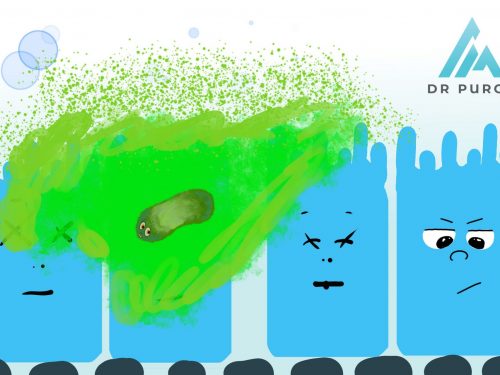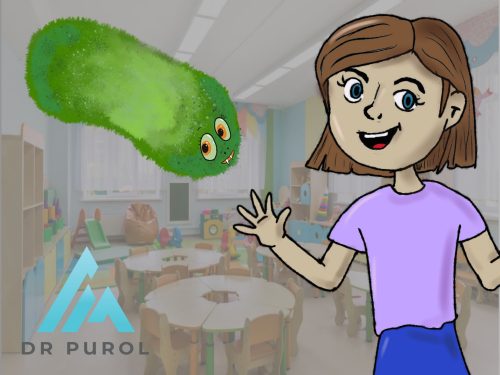
Whooping Cough in a Nutshell: When a COUGH Becomes Dangerous
Whooping cough is a serious acute infectious respiratory disease that, despite available vaccinations, still poses a growing threat. The best way to protect against its severe course is vaccination and avoiding contact with infected individuals. But why are we seeing a noticeable increase in cases this year? Why doesn’t administering antibiotics suffice to stop the cough? Why can quick diagnosis and appropriate treatment significantly shorten the contagious period and reduce the risk of complications?
Whooping cough, also known as pertussis, is caused by the bacterium Bordetella pertussis, which leads to inflammation of the trachea and bronchi.

Symptoms and Course of Whooping Cough:
Whooping cough starts like a common cold, indistinguishable from a regular infection, but over time develops into characteristic, intense coughing fits. Here’s a typical picture of this disease in children:
Catarrhal Stage
- Symptoms: dry cough, runny nose, low-grade fever, sore throat.
- Duration: 1-2 weeks.
Paroxysmal Stage:
🤧 Paroxysmal nature of the cough: series of several strong coughs on a single exhalation.
🐔 Deep, wheezing inhalation resembling a rooster crowing, ‘whooping.’
🤢 Vomiting at the end of a coughing fit.
😰 Facial changes: redness, cyanosis, tearing, salivation, bulging eyes.
💥 Possibility of petechiae on the face, conjunctival hemorrhages, and nosebleeds.
👶 In infants, apnea and seizures may occur.
This stage lasts 2-4 weeks.
Convalescent Stage:
- The cough gradually eases but can persist for several weeks.
- The frequency and intensity of coughing fits decrease, but the cough still worsens at night.
- Irritants, emotions, and temperature changes can provoke coughing fits.
How Can You Get Infected?
Whooping cough is extremely contagious. The risk of infection after contact is over 80%, making it more contagious than chickenpox. Infection usually occurs through airborne droplets via direct contact with an infected person.

The highest contagiousness occurs in the first two weeks of the disease, but without proper antibiotic therapy, a person with whooping cough can be contagious for 3-4 weeks, even if symptoms are mild.
Treatment
In the catarrhal stage, the earliest and least characteristic phase, the use of appropriate antibiotics, such as:
- macrolides (e.g., clarithromycin, azithromycin) or
- cotrimoxazole,
can halt the progression of the disease.
In the developed cough phase, antibiotics shorten the period of contagion but do not affect the symptoms and course of the disease.
The cough is a result of damage to the respiratory tract by bacterial toxins, so while antibiotics are effective in combating the bacteria, they do not alleviate clinical symptoms because they do not act on the toxins. Unfortunately, there are no medications with proven effectiveness in relieving whooping cough in the developed phase. We provide symptomatic medications – trying to facilitate expectoration or choosing medications that suppress the cough reflex.
A patient stops being contagious after 5 days of proper antibiotic therapy.
Preventing Whooping Cough:
Vaccinations against whooping cough have been available in Poland since the 1950s and are the best form of prevention. Unfortunately, protection after vaccination lasts 5 to 10 years. After the disease, immunity lasts slightly longer, 7-20 years. Therefore, one can get whooping cough several times in a lifetime. However, we know that vaccination ensures a milder course of the disease. Additionally, by increasing the immunity of adults and older children, we reduce the risk of infection in infants (cocoon vaccination). The vaccination program includes three doses of the primary vaccination and three booster doses. They are administered to children as part of the protective vaccination program and in Poland are reimbursed by the National Health Fund (NFZ).
Statistics and Current Threats:
Before the pandemic, from 2012-2019, about 38,000 cases of whooping cough were recorded annually. In 2023, 23,000 cases were reported, and in the first three months of 2024, the number had already exceeded 32,000. Whooping cough poses a significant threat, especially to infants under 6 months of age who are unvaccinated or partially vaccinated. In this patient group, the disease can even be fatal.
Disease Diagnosis:
Diagnosis is most often based on characteristic symptoms. Why? Because the most accurate and reliable, and also the most expensive, diagnostic tool that can detect the whooping cough bacterium in the early stage of the disease is molecular diagnostics. The detection of Bordetella pertussis DNA in the nasopharynx by PCR is definitive for diagnosis. There is no such thing as a carrier state of whooping cough bacteria.
Serological testing is time-consuming and, in the face of vaccinations, can present diagnostic difficulties. Additionally, the production of disease-specific antibodies begins only at the end of the catarrhal stage, after about 2 weeks of illness. A culture for whooping cough, while it detects bacteria at an early stage, takes 7-21 days to grow, which is also long.
If your previously healthy child has had a persistent cough for several weeks, consider whooping cough!






